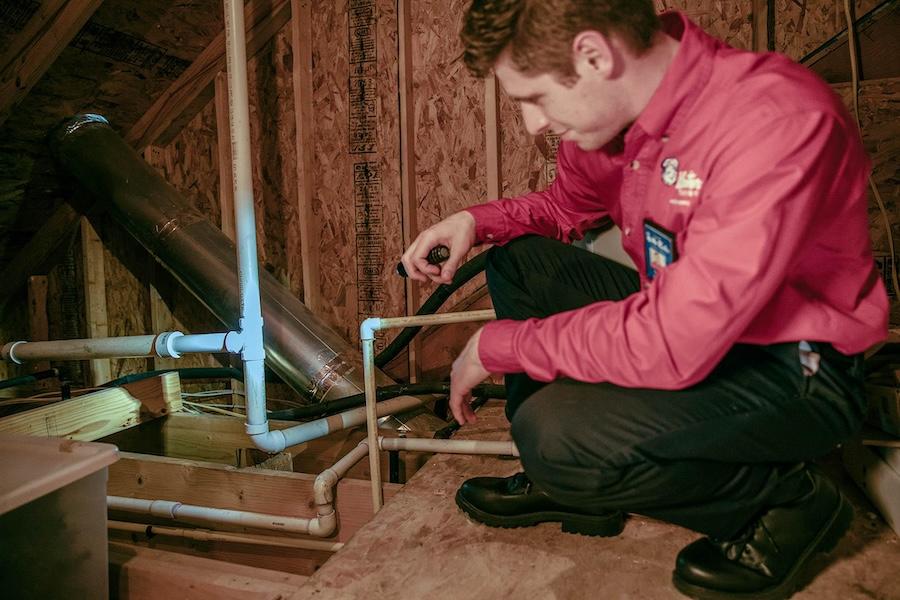Call This Friday to Get $50 OFF
Call us Now to Get $50 OFF.
Ratings based on 6379 reviews
Local Plumbers, Local Reviews
Call This Friday to Get $50 OFF
Call us Now to Get $50 OFF.
Ratings based on 6379 reviews
Local Plumbers, Local Reviews

Cold snaps can do real damage to your home. Burst pipes are one of the most expensive problems that homeowners deal with in winter, and they’re usually preventable. Insulating your pipes is one of the simplest ways to reduce the risk of freezing and avoid expensive repairs. Mr. Rooter Plumbing has seen what can happen when pipes are left unprotected. If you want to avoid calling a plumber in the middle of the night, it’s time to get serious about pipe insulation. Keep reading to learn how to do it right.
Before you head to the hardware store, take stock of your pipes. Focus first on those most at risk, like exposed pipes in basements, crawl spaces, attics, garages, and along exterior walls. These are the areas most vulnerable to freezing, especially in older houses without consistent heating. You’ll need a few basic materials like pipe insulation sleeves, heat tape, zip ties or duct tape, and possibly fiberglass insulation for odd-shaped areas. Measure the length and diameter of your pipes before shopping. Most residential pipes are either ½-inch or ¾-inch in diameter, so grab insulation that fits snugly. Skip the generic “winterizing kits” unless you’ve confirmed they include what you actually need. Instead, build your own setup that fits your home. If you’re unsure about pipe sizes or insulation thickness, call a plumber or ask an expert at your local supply store.
Foam insulation is the most popular option for DIYers. It’s affordable, lightweight, and easy to cut and wrap. Foam sleeves usually come pre-slit, so all you have to do is slip them over the pipe and secure them with tape. They’re great for long, straight pipe runs in places that don’t see a lot of foot traffic or moisture. Rubber insulation is slightly more expensive but holds up better in high-moisture areas like basements. It’s more flexible than foam and has a longer lifespan. Rubber also resists mold growth and can handle temperature fluctuations better than basic foam. If you have pipes that heat up and cool down frequently, like near water heaters, rubber is a better bet. Fiberglass insulation wrapped with plastic or foil is useful for larger pipes, awkward angles, or high-heat systems. It takes more time to install and can be itchy to work with, so wear gloves and long sleeves. It’s not usually the first choice for standard residential pipe runs, but it’s helpful for commercial or high-pressure systems. Choosing the right insulation depends on the pipe’s location, the climate you live in, and how permanent you want the solution to be.
Once you’ve got your materials and know which pipes you’re insulating, it’s time to get to work.
This isn’t just a one-time task. It’s a good idea to inspect your insulation every fall, especially before the first frost. If you notice any moisture damage, rodent nibbling, or slippage, make repairs immediately to maintain the effectiveness of the protection.
While pipe insulation is one of the easier plumbing projects, there are situations where it makes more sense to bring in a plumber in Jurupa Valley. If your pipes are already leaking, sweating, or corroded, insulation won’t solve the problem. You may need a pipe repair before any protective measures can be effective. Also, if you’re dealing with complicated pipe layouts, very old plumbing, or you’re installing insulation in a tight crawl space, a plumbing repair service can help you avoid mistakes that could lead to long-term damage. Professionals can also help install advanced solutions like automatic pipe heating systems or hard-to-source materials that last longer. Don't put insulation on top of a damaged pipe. If a pipe freezes and cracks, the insulation might hide the problem until it becomes a serious leak. In that case, the cost of delaying a pipe repair could far exceed the cost of calling for help early. Some homeowners choose to insulate their main supply lines themselves but leave the tougher spots, like the crawlspace or behind appliances, to a professional. That’s a smart compromise if you want to be involved but don’t want to risk missing something important.
Pipe insulation helps reduce heat loss on hot water lines, lowers your energy bills, and protects against everyday wear. If you’re already dealing with low water pressure, odd noises in your walls, or signs of past freeze damage, it may be time to call a plumber to inspect your system. A plumbing repair service should always be done before applying insulation to maintain the integrity of your system. If you need help, call Mr. Rooter Plumbing today. Our plumbers in Pinon Hills can evaluate your setup, make repairs if needed, and complete professional insulation for total peace of mind.
Old houses have a charm that many new ones are never able to replicate. The entire atmosphere, the…
Read MoreMaintaining a septic system isn’t about preventing future backups but rather the costly repairs and replacements in the…
Read MoreA gas smell in the kitchen can seem harmless at first, but it is an early warning sign…
Read MoreSeptic professionals visit your property to do a thorough examination of your septic system to ensure everything is…
Read MoreMost homeowners don’t think about their septic system until they smell something wrong. The septic system plays a…
Read More